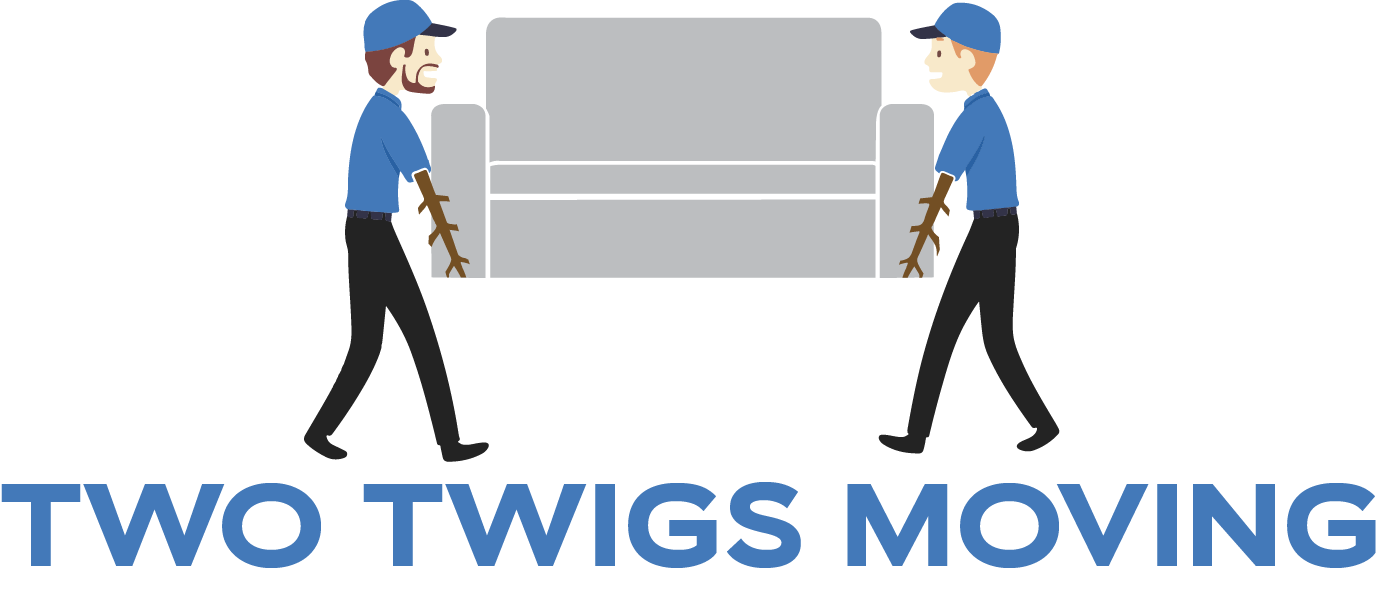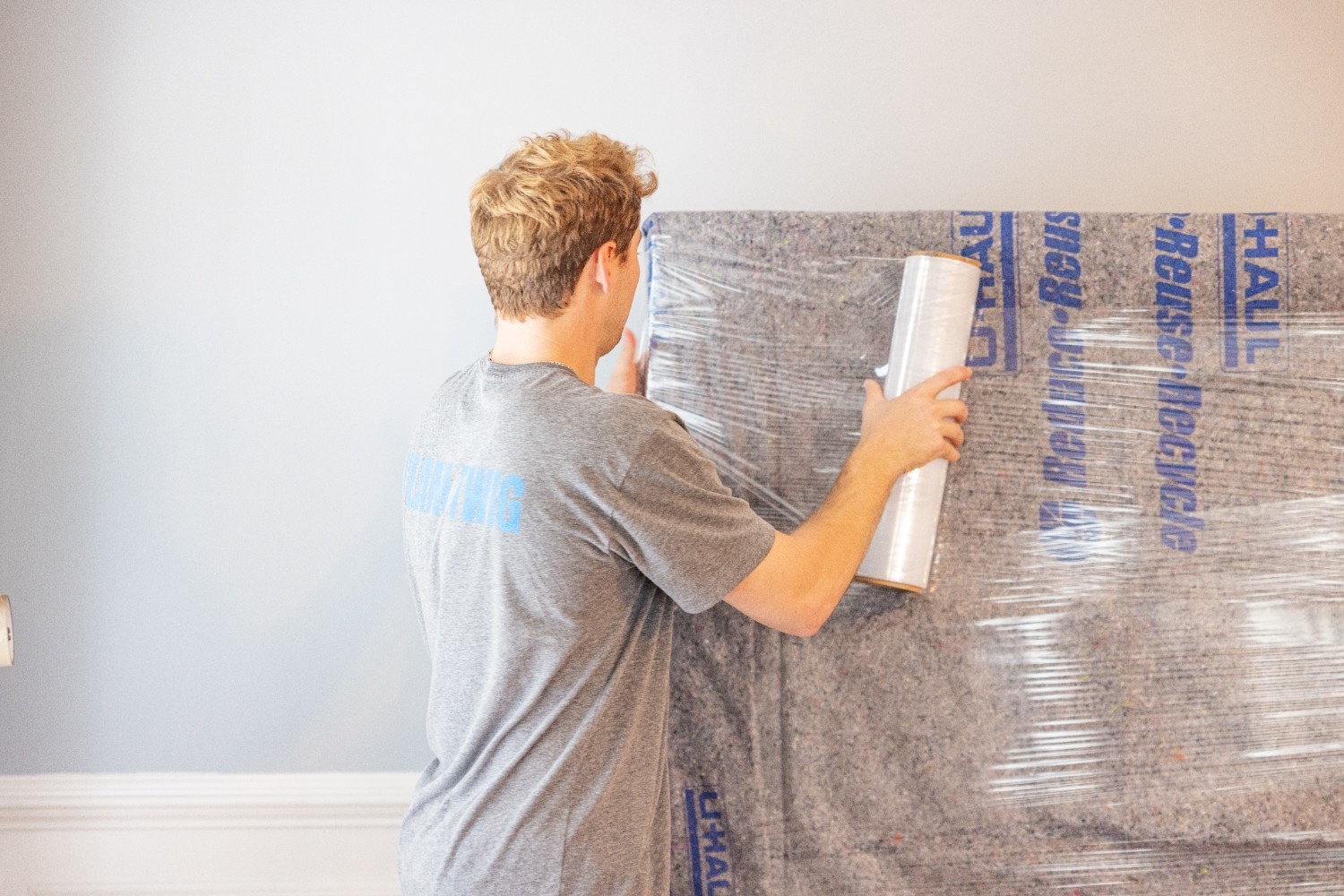Moving can be stressful, but protecting your furniture doesn’t have to be. Here’s how you can ensure your pieces arrive at your new home damage-free:
- Plan and Measure: Take accurate measurements of your furniture and doorways to avoid surprises.
- Disassemble Large Items: Beds, tables, and shelves are easier to move when taken apart. Keep hardware organized.
- Wrap and Pad Properly: Use bubble wrap, blankets, and plastic wrap to shield wood, upholstery, and glass from damage.
- Load Strategically: Place heavy items first, fragile pieces on top, and secure everything with straps.
- Label Clearly: Mark items with room destinations and handling instructions.
- Handle Fragile Items with Care: Use sturdy boxes for glass and mirrors, keeping them upright.
- Consider Professional Movers: For heavy or delicate items, experts can save you time and prevent costly damage.
Measure and Plan Before Moving Day
Taking accurate measurements is the key to avoiding moving day headaches – like discovering your couch can’t squeeze through the front door or realizing your dining table won’t make it up the stairs. Careful planning not only prevents these surprises but also sets the stage for a smoother moving process.
Start by measuring your furniture. Note the height, width, and depth of each piece, and for sectional sofas, include the diagonal depth to ensure they can pivot through tight spaces like doorways. Use a sturdy metal tape measure for accuracy, and double-check your numbers to avoid errors.
Next, turn your attention to the pathways your furniture will travel. Measure doorways (inside the frame), hallway clearances, and note obstacles like doorknobs, light fixtures, or trim. For staircases, measure the width and the distance from the stairs to the ceiling. If you’re in an apartment building, don’t forget to measure the elevator’s interior dimensions, including its height, width, and depth.
Once you’ve gathered all these measurements, put together a detailed plan. Create an inventory of your furniture, listing items room by room, starting with the larger pieces. Record each item’s dimensions, weight, and any fragile parts to keep track of what needs extra care. Use painter’s tape to outline the furniture’s footprint on the floor – this visual guide can help you organize the loading process and ensure nothing is left out. When comparing furniture dimensions with pathway clearances, add an extra 1–2 inches of wiggle room to avoid any tight squeezes.
Decide if disassembly is necessary based on your measurements. Items like beds, dining tables, large shelves, desks, and sectional sofas often need to be taken apart for easier transport. IKEA furniture, for instance, is designed with disassembly and reassembly in mind, making it a great option for movers. Smaller pieces, like chairs, are typically easy to move intact and don’t require disassembly.
For sofas and chairs, ensure the width of your entryway exceeds one of these three measurements: the piece’s depth, diagonal depth, or height. If none of these align, disassembly may be your only option.
To make things even more efficient, assign a color code to each room in your new home and label your furniture accordingly. This system helps movers place items in the right spots, saving you the hassle of rearranging later. Use this planning phase to separate items you want to donate, sell, or discard. For an added layer of preparation, sketch out your new room layouts on graph paper to visualize where everything will go before moving day.
Take Apart Large Furniture Pieces
Disassembling large furniture is a smart way to make your move easier and more efficient. Breaking down bulky items reduces the risk of damage, frees up space in the moving truck, and can even help cut costs.
"Disassembly reduces the risk of damaging the furniture or the property. It prevents awkward angles or stress on joints of furniture that can lead to breakage or scraping against walls and doors."
– Wendy Hoke, Alliance Relocation Services
What should you take apart? Focus on larger items like beds, tables, large shelves, desks, and couches – basically, anything too big or awkward to move as is. Smaller pieces, like chairs, can usually stay intact if they fit easily through doorways and into the truck.
Gather your tools first. Make sure you have the right tools on hand before diving in. You’ll need screwdrivers, wrenches, Allen keys, hammers, and pliers. A power drill can also speed things up. Using the correct tool sizes is crucial to avoid stripping screws or damaging hardware.
Take photos before you begin. Snap pictures of each piece from different angles. Pay close attention to complex joints or connections – these photos can be a lifesaver when it’s time to reassemble.
Keep hardware organized. Losing screws and bolts can turn reassembly into a nightmare. Use resealable bags to store hardware, label each bag clearly, and create an inventory list for every piece of furniture. You can also sketch a quick outline of the furniture, mark bolt locations, and label corresponding hardware for extra clarity.
Check the manufacturer’s instructions. If your furniture came with an assembly guide, refer to it for disassembly. This is especially helpful for intricate items like entertainment centers or modular furniture.
Once everything is disassembled, you’re ready to move on to wrapping and padding each piece to keep it safe during transit.
Wrap and Pad Your Furniture Correctly
Once you’ve disassembled your furniture, the next step is to wrap and pad each piece properly. Using the right materials for different types of furniture – like wood, upholstery, or glass – helps protect them from damage during the move. This step builds on the careful disassembly process to ensure your furniture is ready for a safe journey.
Before wrapping, make sure to clean all surfaces to remove any dirt or debris that could cause scratches. For wooden pieces, polish the surfaces, and for items with drawers or shelves, empty them to avoid unsecured parts during transit.
How to Protect Wood Furniture
Wood furniture requires extra care because it’s sensitive to both physical damage and moisture. Avoid letting plastic wrap touch wood directly, as it can trap moisture, leading to warping or mildew.
Start by covering all surfaces with bubble wrap, paying close attention to corners, legs, and any delicate edges. Wrap furniture legs individually and use cardboard to reinforce edges. For ornate or carved details, consider creating custom cardboard corner protectors to shield these vulnerable areas.
Next, cover the entire piece with moving blankets, securing them tightly with stretch wrap or tape. The blankets provide cushioning and act as a barrier between the wood and any plastic layers. For high-gloss or mirror-like finishes, add foam padding underneath the blankets for extra protection.
Special care for antiques: Use acid-free materials for parts that come into direct contact with finished surfaces. This prevents chemical reactions that could harm the wood over time.
Wrap Upholstered Furniture Properly
Upholstered furniture requires a slightly different approach. Unlike wood, it can come into direct contact with plastic wrap. Start with a layer of plastic wrap to create a moisture barrier, protecting the fabric from dirt and spills.
After wrapping the piece in plastic, cover it with moving blankets for added cushioning. Secure the blankets with packing tape to keep everything in place. For particularly valuable items like sofas or armchairs, use specialized plastic covers for maximum protection.
Don’t forget the loose parts. If you’ve removed sofa legs or other components, wrap them separately and store the hardware in labeled bags, just as you did during disassembly.
Pack Glass and Mirrors Safely
Glass and mirrors are the most fragile items and need extra attention. Start by applying painter’s tape in an "X" pattern across the glass to minimize the risk of shattering. Then, wrap the entire surface with bubble wrap, focusing on corners and edges for added protection. Place the wrapped items in sturdy mirror boxes for safer transport.
Layer your protection. Add a layer of packing paper directly against the glass, followed by bubble wrap or cardboard for extra padding. This multi-layered approach helps distribute impact forces and reduces the chances of breakage.
For especially valuable or irreplaceable glass pieces, consider using custom crating materials. While this might increase your moving costs, it provides unparalleled protection during transit.
Load and Secure Items in the Moving Truck
Once your furniture is disassembled, wrapped, and padded, the next step is to load and secure everything in the truck. Proper loading ensures your belongings stay safe during transit, even on bumpy roads or during sudden stops. The goal? A stable setup where nothing shifts. To achieve this, focus on strategic placement, balanced weight distribution, and securing everything tightly.
Start with the Heaviest Items
Begin by loading the heaviest furniture pieces onto the truck floor. Items like couches, dressers, refrigerators, washers, dryers, and dining tables should go in first. Place these heavier items toward the truck’s front, near the cab, and use the walls as stabilizers. Distribute the weight evenly from left to right for better balance. If you have especially heavy items, like a piano or a large armoire, center them and balance their weight with other heavy pieces on the opposite side. Once the big items are in place, fill any gaps with smaller boxes or padding to prevent shifting. Lighter boxes, particularly those containing fragile items, should go on top of this sturdy base.
Secure Everything with Straps
Ratchet straps are your best friend when it comes to securing furniture in a moving truck. To use them, thread the strap through the ratchet head, position your furniture snugly against the truck wall, and attach the strap hooks to the metal bars inside the truck. Then, tighten the ratchet until the item is firmly held in place. Be careful not to overtighten, especially with wooden or upholstered furniture, as this could cause damage. Check the tension during stops to ensure everything stays secure. Use padding or blankets to fill any gaps around the furniture before strapping, which helps prevent movement during the drive.
Handle Glass Items with Extra Care
Glass and mirrors need special attention. Always keep glass boxes standing upright – laying them flat increases the risk of cracks due to pressure points. Clearly label these boxes with "DO NOT LAY FLAT" to make sure everyone handles them correctly. Position these fragile items in areas where they’re less likely to be bumped by heavier pieces, and keep them away from truck walls to avoid exposure to extreme temperature changes. Place lighter boxes containing glassware on top of your heavy furniture foundation to create a stable, weight-distributed pyramid.
These techniques, combined with the protective measures you’ve already taken, will help ensure your belongings arrive at your destination without damage.
sbb-itb-a5538b6
Add Clear Labels and Moving Instructions
Once your furniture is securely wrapped and ready to go, adding clear labels is the next step to keep everything organized and protected during your move. Labels not only help movers handle items correctly but also ensure they end up in the right room, making the unpacking process much smoother.
Labeling might seem like a small detail, but it can turn a potentially chaotic moving day into a well-coordinated effort. To make labels effective, place them on at least three sides of each item so they remain visible, even when pieces are stacked. This ensures movers can easily identify and handle items properly, reducing the chances of damage.
When labeling, include key details such as the item’s description, its destination room, and any special handling instructions. For instance, a dining table label might read: "Dining Table – Kitchen – Handle with Care." This simple addition communicates what the item is, where it belongs, and how to treat it.
For fragile items, like glass shelves or delicate electronics, go a step further. Use bold "FRAGILE" labels on multiple sides and add directional arrows with "THIS SIDE UP" to help movers maintain the correct orientation. This is especially important for items like lamps, artwork, or anything that could be damaged if improperly positioned.
Adding a layer of visual organization, such as color-coding, can make things even easier. Assign a specific color to each room and mark items accordingly – blue for the bedroom, green for the kitchen, and red for the living room, for example. This allows movers to quickly identify where each item should go without needing to read every label.
For disassembled furniture, label each component clearly and keep all hardware secured to the main piece. For example, drawers from a dresser could be labeled as "Master Bedroom Dresser – Drawer 1, Drawer 2," and so on. This keeps everything together and makes reassembly a breeze.
To protect your labels from smudging or tearing, cover them with clear packing tape. This ensures they remain legible throughout the move, even if items are exposed to moisture or rough handling.
Creating a master inventory list to complement your labeling system can also be a lifesaver. Number each major piece and keep a detailed list noting the item’s description, condition, and destination room. This serves as a backup in case any labels are damaged or lost during transit.
Finally, make sure to prioritize your essentials. Clearly mark boxes or furniture with critical items as "Open First" or "Essentials" so you can easily access them when you arrive at your new place.
Get Professional Help for Heavy or Delicate Items
Once your furniture is secured and prepped, some items still demand a professional touch. When it comes to extremely heavy or delicate pieces, expert handling can make all the difference. Proper techniques, like wrapping and padding, help minimize damage, but certain items – like pianos or pool tables – require specialized knowledge and equipment. According to the Bureau of Labor Statistics, overexertion from lifting remains one of the leading causes of workplace injuries, with 2.6 million non-fatal injuries reported in 2023 alone.
Professional movers bring the tools and expertise needed to safely handle these challenging items. For instance, pianos can weigh anywhere from 300 to 1,200 pounds, depending on the model. Moving such a heavy and intricate piece isn’t just about strength – it requires dollies, straps, and the right techniques to avoid damaging the instrument, your home, or yourself.
"Moving specialty and heavy items often require disassembly and/or construction of a custom crate for proper transportation to the new location. At times we find moving these items by yourself can cause bodily injury and more often damage to the item you’re moving. Damage to an item can sometimes cost more than the move itself." – North Bay Movers
While professional movers may charge $80–$100 per hour for local moves and $2,000–$5,000 for cross-country services, they provide insurance that DIY efforts simply can’t match. Although the upfront cost might seem steep, the potential expense of repairing or replacing damaged items often surpasses the cost of hiring professionals. Insurance coverage offered by moving companies adds another layer of protection, giving you peace of mind.
For example, Two Twigs Moving, serving Charlotte, Charleston, and Greenville, specializes in handling heavy and delicate items. They excel at disassembling, packing, and reassembling challenging pieces with precision. With an "Excellent" rating and 181 glowing reviews, many customers highlight their careful approach.
Elizabeth Olivier, who completed her 12th move in February 2025, shared her story:
"These guys are amazing in so many ways! I have moved 12 times in my life & this crew was the most protective of my stuff ever. I have some older, heirloom furniture which has always gotten a little dinged in moves, but not this time! They literally shrink wrapped it all before packing it so carefully in their trucks. Plus they worked constantly to get it done. I felt bad for what they had to do, even moving my pool table. I expressed how sorry I was yet they were cheerful throughout!"
Stories like Elizabeth’s highlight the value of leaving heavy or delicate items to professionals. Experienced movers are skilled at navigating tricky spaces like staircases and tight corners without causing damage to your home or belongings. They’re trained to handle the kinds of challenges that often trip up DIY movers.
When hiring movers, make sure to ask about their experience with heavy or fragile items, confirm their insurance coverage, and request a detailed estimate of services. Checking reviews and understanding your options for insurance coverage can also help ensure a smooth experience.
Having professionals manage the most challenging parts of your move can save you from costly mishaps. Their secure loading and transport methods significantly reduce the risk of breakage, especially for items with sentimental or high monetary value. Sometimes, it’s worth the investment to ensure your cherished belongings arrive safely at their new home.
Conclusion: 7 Ways to Keep Your Furniture Safe During Moving
Moving can be a stressful process, but with the right approach, you can protect your furniture and ensure everything arrives in great condition. It all comes down to preparation, protection, and proper execution.
Planning ahead is the first step toward a smooth move. As one expert puts it, "Planning ahead and being prepared are highlighted as key secrets to achieving a smooth move. Embracing this mindset from the outset is crucial for setting yourself up for success". Taking the time to map out your move can save you from unnecessary headaches later.
When it comes to protecting your furniture, wrapping and padding are essential. Tools like moving blankets, bubble wrap, and plastic stretch wrap act as shields against scratches, moisture, and dirt. But wrapping alone isn’t enough – how you load your items matters just as much.
Speaking of loading, securing everything in the truck is critical. Heavy items should go in first, followed by careful strapping to keep everything in place. Don’t forget to keep glass items upright to minimize risks during transit.
For those especially valuable or difficult-to-move pieces, turning to professional movers can make all the difference. Professionals bring the right equipment, training, and insurance, offering peace of mind that DIY efforts often can’t match.
If you’re in Charlotte, Charleston, or Greenville, Two Twigs Moving is ready to assist. Their team has experience handling everything from standard furniture to specialty items like pianos and pool tables, ensuring your belongings get the care they need to arrive safely at your new home.
FAQs
How can I make sure my furniture fits through doorways and staircases when moving?
Before moving, start by measuring doorways, hallways, and staircases in both your current and new home. Grab a tape measure and note the height, width, and depth of each piece of furniture. Then, compare these measurements with the dimensions of the spaces you’ll need to navigate during the move.
For bulkier items, you might need to tilt or rotate the furniture at an angle to squeeze through tight areas. Detachable parts, like legs, cushions, or tabletops, can often be removed to make things more manageable. Move slowly and carefully, and don’t forget to use padding to shield both your furniture and walls from scratches or dents.
What are the best materials to use for protecting furniture during a move?
To keep your furniture safe during a move, rely on materials like moving blankets, bubble wrap, plastic stretch wrap, foam padding, and corrugated cardboard sheets. These provide a protective barrier against scratches, add cushioning for fragile spots, and help secure items during transportation.
If you’re dealing with delicate or antique furniture, adding extra layers of padding or wrapping is a smart choice. Investing in sturdy, reliable packing materials can go a long way in ensuring your furniture stays intact throughout the journey.
When is it a good idea to hire professional movers instead of moving on your own?
Hiring professional movers can make your life a whole lot easier, especially when time is tight or you’re dealing with heavy, delicate, or high-value items like pianos or antiques. They come equipped with the skills and tools to handle your belongings with care, saving you from the physical strain and potential mishaps of doing it yourself.
If you’re juggling a packed schedule, lack the right equipment, or feel overwhelmed by packing and organizing, professional movers can take the weight off your shoulders – literally and figuratively. Their expertise can streamline the process, making the whole experience far less stressful and giving you the confidence that your move is in good hands.


.svg)


